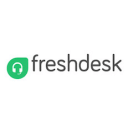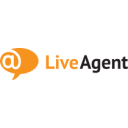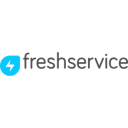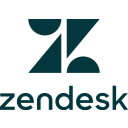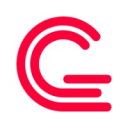Freshdesk vs Front: Choosing the best helpdesk for your team
- 01Freshdesk vs Front: overview
- 02What's the difference between Freshdesk and Front?
- 03Freshdesk pros and cons
- 04Front pros and cons
- 05Freshdesk compared to Front
- 06Front compared to Freshdesk
- 07Features comparison
- 08Freshdesk vs Front: Which is the best for your business?
- 09Promotions on Customer Support software
- 10Alternatives to Freshdesk & Front
Access up to $100,000 savings on Freshdesk & $4,740 on Front
Front
6 months free on Growth plan
Access up to $100,000 savings on Freshdesk & $4,740 on Front
Front
6 months free on Growth plan
Many businesses rely heavily on efficient customer support and communication tools to manage interactions, support tickets, and team collaboration. However, without the right platform, managing these processes can become cumbersome, leading to delayed responses, disjointed communications, and ultimately, unsatisfied customers. Fortunately, several robust solutions are available that help businesses streamline their support operations.
Freshdesk and Front are two leading customer support platforms in the market. To help you determine which tool is best suited for your business needs, we’ve prepared a detailed comparison of their key features, major differences, and pricing models. Let’s take a closer look at Freshdesk vs Front.
Freshdesk vs Front: overview
Freshdesk and Front are both prominent players in the customer support and communication platform space, each offering unique features and strengths tailored to different business needs.
Freshdesk is renowned for its comprehensive helpdesk capabilities, providing a robust suite of tools for managing customer inquiries, support tickets, and automation workflows. It excels in delivering a traditional support experience with a user-friendly interface, making it easier for teams to track, prioritize, and resolve customer issues efficiently. On the other hand, Front takes a more collaborative approach to customer communication by centralizing all messages—emails, social media, SMS, and more—into a single inbox that teams can manage together.
Now, let's delve deeper into the Freshdesk vs. Front comparison to help you make a well-informed decision when it comes to selecting the most suitable customer support and communication platform for your specific business needs.
What's the difference between Freshdesk and Front?
Freshdesk and Front are both powerful platforms designed to enhance customer support and team collaboration, catering to businesses of various sizes. With intuitive interfaces and a broad range of features, both tools are suitable for users of all technical backgrounds. However, key differences between Freshdesk and Front should be considered when deciding which platform is best for your business.
The primary difference lies in their approach to customer support and communication. Freshdesk is built around a traditional helpdesk model, where customer inquiries are managed through a ticketing system. This structure makes it easy to organize, prioritize, and track customer issues, ensuring that no query goes unresolved. Freshdesk is particularly well-suited for businesses that require a structured, process-driven approach to customer support, especially those dealing with high volumes of tickets. It also offers advanced automation, analytics, and integrations with other business tools, making it a comprehensive solution for customer support teams.
On the other hand, Front focuses on team collaboration and communication by centralizing all customer messages—whether via email, SMS, social media, or other channels—into a shared inbox. This allows multiple team members to collaborate on the same conversation in real-time, providing a more unified and responsive customer experience. Front is ideal for teams that prioritize seamless communication and transparency, as it enables every team member to see the entire context of a customer interaction and contribute to it as needed. It’s particularly beneficial for organizations that deal with complex, multi-channel communication.
In terms of pricing, both Freshdesk and Front offer various plans depending on the needs of your business. Freshdesk typically charges per agent, with tiered plans offering increasing access to advanced features. Front, however, charges based on the number of users and the features required, with plans that cater to teams of different sizes and collaboration needs.
Freshdesk pros and cons
What are the advantages of Freshdesk?
- Comprehensive ticketing system: Freshdesk offers a robust ticketing system that helps streamline customer support by allowing teams to manage, prioritize, and resolve customer queries efficiently. The automation features further enhance productivity by automating routine tasks.
- User-friendly interface: Freshdesk is known for its intuitive and easy-to-navigate interface, making it accessible for users of all technical levels. The platform is designed to minimize the learning curve, enabling teams to get up and running quickly.
- Strong integrations: Freshdesk integrates with a wide range of third-party tools, including CRM systems, communication platforms, and project management tools. This allows businesses to create a unified workflow across different platforms.
- Multi-channel support: Freshdesk supports various communication channels, including email, phone, live chat, social media, and more. This ensures that businesses can engage with customers on their preferred platforms, enhancing the overall customer experience.
- Scalable plans: Freshdesk offers a variety of pricing plans, making it suitable for businesses of all sizes. As your business grows, you can easily upgrade to a plan that offers more advanced features and capabilities.
What are the disadvantages of Freshdesk?
- Limited customization: While Freshdesk offers a range of features, some users may find its customization options limited, especially for businesses with highly specific or complex needs.
- Complexity in advanced features: For smaller businesses or teams without dedicated IT support, the more advanced features of Freshdesk can be complex and difficult to implement without significant time and effort.
- Pricing for add-ons: Some of Freshdesk’s more advanced features and add-ons, such as AI-powered automation and advanced reporting, are only available in higher-tier plans or as additional purchases, which can increase overall costs.
- Performance issues with large data sets: Some users have reported performance slowdowns when dealing with very large volumes of tickets or customer data, which can affect efficiency in high-demand environments.
- Limited reporting capabilities in lower plans: While Freshdesk offers robust analytics, the reporting features in the lower-tier plans can be quite basic, limiting insights for businesses that need more detailed analytics without paying for higher-tier plans.
Compare Freshdesk to other tools
Front pros and cons
What are the advantages of Front?
- Unified inbox for team collaboration: Front centralizes all customer communication channels—email, SMS, social media, and more—into a single shared inbox. This allows teams to collaborate seamlessly on customer conversations, ensuring that everyone is on the same page.
- Real-time collaboration: Front enables multiple team members to work on the same customer conversation simultaneously. This real-time collaboration is particularly beneficial for handling complex queries that require input from different departments.
- Transparent communication: Front’s transparency features allow team members to see the entire context of a customer interaction, including who is working on what. This reduces duplication of efforts and improves response times.
- Customizable workflows: Front offers a high degree of customization, allowing teams to create workflows that match their specific processes. This flexibility makes it easier to tailor the platform to suit various business needs.
- Integrations with popular tools: Front integrates with a wide range of third-party tools, including CRM systems, project management software, and customer support platforms. This allows businesses to create a cohesive tech stack that supports their entire customer communication process.
What are the disadvantages of Front?
- Higher cost for larger teams: Front’s pricing is based on the number of users and the features needed. For larger teams, this can become expensive, especially if advanced features are required.
- Limited traditional ticketing system: Unlike platforms like Freshdesk, Front does not offer a traditional ticketing system. For businesses that rely on structured ticket management, this can be a drawback.
- Steep learning curve: While Front is powerful, it can be complex for new users. The platform’s flexibility and range of features may require significant time to learn and implement effectively.
- Dependence on email for core functionality: Front’s core strength lies in email communication. For businesses that rely heavily on other channels like live chat or phone support, Front may not be as comprehensive as other solutions.
- Limited reporting and analytics in lower plans: While Front offers reporting features, the analytics available in lower-tier plans can be limited. Businesses needing in-depth insights may need to invest in higher-tier plans or additional tools.
Compare Front to other tools
Freshdesk compared to Front
Freshdesk and Front serve distinct purposes in the customer support landscape. Freshdesk excels in providing a structured helpdesk experience with robust ticket management, making it ideal for businesses that need to organize, prioritize, and automate customer inquiries systematically.
In contrast, Front focuses on team collaboration by centralizing all communication channels into a shared inbox, allowing real-time collaboration on customer interactions. While Freshdesk offers a more traditional approach to support with comprehensive features, Front is better suited for teams that prioritize seamless, transparent communication across multiple channels.
Is Freshdesk better than Front?
Whether Freshdesk is better than Front depends on your specific business needs. Freshdesk is ideal for organizations seeking a structured, traditional helpdesk solution with strong ticket management and automation capabilities. It excels in environments where organizing and prioritizing customer inquiries is crucial.
On the other hand, Front is better suited for teams that require a collaborative approach to customer communication. Its unified inbox and real-time collaboration features make it a powerful tool for businesses that need to manage interactions across multiple channels seamlessly.
What is Freshdesk best used for?
Freshdesk is best used for managing customer support operations through a structured and efficient helpdesk system. It is ideal for businesses that handle a high volume of customer inquiries and require a centralized platform to organize, prioritize, and resolve tickets. With features like automation, multi-channel support, and integration with other business tools,
Freshdesk streamlines the entire support process, ensuring that no customer issue falls through the cracks. Its user-friendly interface and powerful reporting capabilities make it particularly useful for teams looking to enhance their support efficiency and maintain high levels of customer satisfaction.
Can Freshdesk replace Front?
While Freshdesk and Front share some overlapping features in customer communication, they serve different purposes and may not be direct replacements for one another. Freshdesk is designed for structured ticket management and excels in organizing, prioritizing, and resolving customer inquiries through a traditional helpdesk model.
Front, on the other hand, focuses on real-time team collaboration across multiple communication channels within a unified inbox. If your business prioritizes detailed ticketing and automated workflows, Freshdesk is ideal. However, if seamless, collaborative communication across channels is more critical, Front might be more appropriate.
Is Freshdesk cheaper than Front?
The cost comparison between Freshdesk and Front depends on the specific plans and features your business requires. Generally, Freshdesk offers a range of pricing tiers, including a free plan and lower-cost options for small teams, making it more affordable for basic customer support needs.
In contrast, Front tends to have higher pricing, particularly for larger teams or businesses requiring advanced collaboration features. While Freshdesk may be cheaper for basic support functions, Front’s pricing reflects its focus on comprehensive communication and team collaboration.
Is there a better Customer Support software than Freshdesk?
Determining if there is a "better" software than Freshdesk depends on your specific customer support and communication needs. Freshdesk is highly regarded for its robust ticketing system, automation capabilities, and multi-channel support, making it a top choice for many businesses.
However, alternatives to Freshdesk like Zendesk, Intercom, and Front may be better suited for certain use cases. Zendesk offers more advanced customization and reporting features, making it ideal for large enterprises. Intercom excels in customer engagement and messaging, focusing on personalized communication. Front, with its shared inbox and team collaboration features, is perfect for businesses prioritizing real-time communication.
90% off the Pro plan for 1 year on Freshdesk
Get 90% off the Pro plan for 1 year on Freshdesk and up to $100,000 savings with Secret.
Front compared to Freshdesk
Front and Freshdesk serve different aspects of customer support and communication. Front is designed for teams that prioritize real-time collaboration across various communication channels, offering a shared inbox where team members can work together on customer conversations seamlessly. It excels in fostering transparency and teamwork.
Freshdesk, on the other hand, is a comprehensive helpdesk solution focused on structured ticket management, making it ideal for businesses that need to organize and automate customer inquiries efficiently. While Front is best for collaborative communication, Freshdesk is better suited for those needing a more traditional, process-driven support system.
Is Front better than Freshdesk?
Whether Front is better than Freshdesk depends on your business's communication and collaboration needs. Front excels in environments where real-time team collaboration and transparency across multiple communication channels are crucial. Its shared inbox feature allows teams to work together seamlessly on customer conversations, making it particularly effective for businesses that prioritize cohesive, responsive communication.
However, if your business requires a more structured, traditional approach to customer support, with a focus on organized ticket management and automation, Freshdesk might be the better choice.
What is Front best used for?
Front is best used for managing customer communication through a unified inbox that centralizes emails, messages, and social media interactions. It is ideal for teams that prioritize real-time collaboration and transparency, allowing multiple team members to work together on the same conversation.
Front excels in environments where seamless communication across channels is critical, helping teams respond quickly and efficiently to customer inquiries. Its strength lies in fostering teamwork, making it particularly valuable for businesses that need to manage complex, multi-channel interactions and ensure that every team member has full visibility into customer communications.
Can Front replace Freshdesk?
Front and Freshdesk serve different purposes, so whether Front can replace Freshdesk depends on your business needs. Front is designed for real-time team collaboration across multiple communication channels within a unified inbox, making it ideal for businesses that prioritize seamless, transparent communication.
However, Freshdesk is a robust helpdesk platform focused on structured ticket management, automation, and organized customer support workflows. If your business relies heavily on traditional ticketing, detailed customer support processes, and extensive automation, Freshdesk is likely more suitable. Front might not fully replace Freshdesk unless your primary need is collaborative communication rather than structured support management.
Is Front cheaper than Freshdesk?
The cost comparison between Front and Freshdesk depends on the specific plans and features your business requires. Generally, Front tends to be more expensive, particularly for larger teams or businesses needing advanced collaboration features, as it charges per user with additional costs for premium functionalities.
Freshdesk, on the other hand, offers a broader range of pricing options, including a free tier and lower-cost plans, making it more affordable for small teams or basic customer support needs. While Front's pricing reflects its focus on team collaboration and multi-channel communication, Freshdesk’s pricing plans are often the more budget-friendly option for traditional support operations.
Is there a better Customer Experience software than Front?
Determining if there is a superior software to Freshdesk, Help Scout, and Zoho Desk depends on your specific customer communication and collaboration needs. Freshdesk excels in centralizing various communication channels into a unified inbox, facilitating real-time team collaboration and transparent customer interactions.
However, alternatives to Front like Help Scout, Zoho Desk, and Intercom offer different strengths. Help Scout provides a more traditional helpdesk experience with robust ticket management and automation features, while Zoho Desk offers advanced customization and reporting, ideal for large-scale support operations. Intercom specializes in customer engagement and personalized messaging.
6 months free on Growth plan on Front
Get 6 months free on Growth plan on Front and up to $4,740 savings with Secret.
Features comparison
Front Outshines Freshdesk with Advanced Team Collaboration Features
Although Freshdesk emphasizes team collaboration by enabling the sharing of tickets within the team, Front takes the lead by offering a more comprehensive set of collaboration tools. Front allows team members to work together on the same message thread in real-time, share drafts before sending, and even leave comments directly within individual messages. For example, if a complex customer query requires input from multiple departments, team members can discuss and refine their responses without leaving the inbox.
This depth of collaboration enhances overall communication, coordination, and coherence within the team, making Front particularly effective for businesses that rely heavily on collaborative efforts to resolve customer issues efficiently.
Both Freshdesk and Front Excel in Multi-Channel Support for Seamless Customer Interaction
Whether it's email, social media, chat, or phone, both Freshdesk and Front provide outstanding multi-channel support, consolidating messages and queries from various platforms into a single, unified inbox. This integration ensures that customer interactions remain seamless, regardless of the communication channel customers choose.
For instance, a customer might start a conversation via email and then continue it through chat; both Freshdesk and Front ensure that the entire conversation history is readily accessible in one place. This unified approach not only enhances the customer experience but also empowers support teams to respond more efficiently and consistently, maintaining context and continuity across all channels.
Freshdesk Edges Out Front in Ease-of-Use for Customer Support
While both Freshdesk and Front provide thoughtful interfaces, Freshdesk excels in terms of ease-of-use, particularly for users who need to get up to speed quickly. Freshdesk sports a clean, intuitive interface that allows even those who aren’t tech-savvy to navigate and accomplish tasks effortlessly. For example, setting up automated workflows or managing support tickets is straightforward and doesn’t require extensive training, making it ideal for fast-paced business environments.
On the other hand, while Front offers robust functionality, it can require more time for users to familiarize themselves with its various capabilities and settings, such as managing multiple communication channels or customizing team workflows. This difference in usability can impact how quickly a team can become proficient with each tool.
Freshdesk Takes the Lead Over Front in Integration Possibilities
In terms of integration possibilities, Freshdesk clearly takes the lead ahead of Front. Freshdesk offers a wide range of integrations with popular third-party tools, including CRM systems like Salesforce, marketing platforms like Mailchimp, and collaboration tools like Slack and Microsoft Teams. For example, businesses can seamlessly connect Freshdesk with their existing CRM to sync customer data, ensuring that support teams have all the information they need at their fingertips.
While Front also offers integrations, particularly focused on communication tools like email and messaging platforms, it doesn’t match the breadth and depth of Freshdesk’s integration capabilities, which are essential for businesses looking to create a fully integrated support ecosystem.
Freshdesk Enhances Unified Inbox with Advanced Ticket Management Over Front
While both Freshdesk and Front offer a unified inbox that consolidates messages from various platforms, Freshdesk takes this functionality a step further by allowing users to manage tickets received from these platforms directly within the same inbox. This added capability results in greater efficiency, as it enables your team to seamlessly transition from communication to ticket management without switching interfaces.
For instance, Freshdesk allows users to predefine responses, automate ticket routing, and set up triggers for specific actions on received tickets, significantly optimizing the support process. This level of automation and streamlined ticket handling makes Freshdesk particularly advantageous for businesses looking to enhance their customer support operations beyond basic communication.
Freshdesk Stands Out with Integrated Surveys for Continuous Customer Satisfaction Improvement
While both Freshdesk and Front excel in facilitating customer interaction, Freshdesk distinguishes itself with a unique feature dedicated to enhancing customer satisfaction continuously. Freshdesk offers integrated customer satisfaction (CSAT) surveys that are automatically sent to customers after a ticket is resolved. These surveys allow businesses to gauge customer satisfaction immediately following an interaction, providing valuable insights into the quality of service provided.
For example, if a customer rates their experience poorly, Freshdesk can alert the support team to take corrective action. This proactive approach ensures that opportunities for service improvement are never missed, making Freshdesk particularly effective for businesses committed to maintaining high levels of customer satisfaction.
Front Surpasses Freshdesk with Advanced Analytics for Deeper Performance Insights
Both Freshdesk and Front offer performance tracking capabilities, but Front takes it a step further by providing more detailed and comprehensive analytics. Front's advanced analytics allow teams to gain deeper insights into their performance, customer engagement, and overall service quality. For example, Front enables users to track response times, monitor customer satisfaction trends, and analyze the volume and nature of interactions across different communication channels.
These detailed insights help teams identify patterns and uncover opportunities for improvement, making it easier to optimize processes and enhance customer service. While Freshdesk offers customizable performance reports, Front's analytics prove to be more insightful and actionable for teams aiming to refine their support strategies continuously.
Subscribe to our newsletters.
No FOMO here. Stay up-to-date on all the latest deals and news with our monthly newsletter straight to your inbox like 112,000+ entrepreneurs (+ Get 10% off on on our Premium Membership!)
Freshdesk vs Front: Which is the best for your business?
Freshdesk is the best tool for you if:
- Your business requires a comprehensive helpdesk solution with advanced ticket management features to efficiently organize, prioritize, and resolve customer inquiries across multiple channels.
- You value a user-friendly interface that minimizes the learning curve, allowing your team to quickly adapt and operate efficiently, even without extensive technical knowledge.
- Automating routine customer support tasks is essential, and you need a tool that offers powerful automation capabilities to streamline workflows and enhance productivity.
- You need robust multi-channel support, enabling your team to manage customer interactions from email, chat, social media, and phone within a single, unified platform.
- Continuous customer satisfaction monitoring is crucial, and you require integrated CSAT surveys to gather feedback post-resolution and drive ongoing service improvements.
Front is the best tool for you if:
- Your team prioritizes real-time collaboration and needs a platform that allows multiple members to work together seamlessly on customer conversations within a unified inbox.
- You require advanced communication features, such as shared drafts and in-message comments, to enhance transparency and coordination within your support team.
- Managing customer interactions across various channels—email, SMS, social media—is crucial, and you need a tool that centralizes these communications into one accessible platform.
- Your business thrives on in-depth analytics and requires detailed insights into team performance, response times, and customer engagement to continuously refine support strategies.
- A transparent workflow is essential, and you need a tool that ensures every team member has full visibility into ongoing customer interactions for consistent, cohesive support.
Alternatives to Freshdesk & Front
Promotions on Customer Support software
Start saving on the best SaaS with Secret.
Secret has already helped tens of thousands of startups save millions on the best SaaS like Freshdesk, Front & many more. Join Secret now to buy software the smart way.

